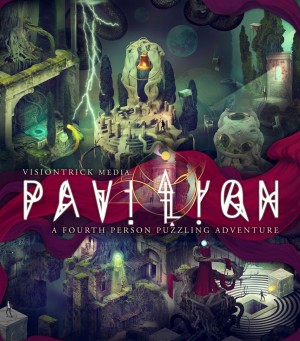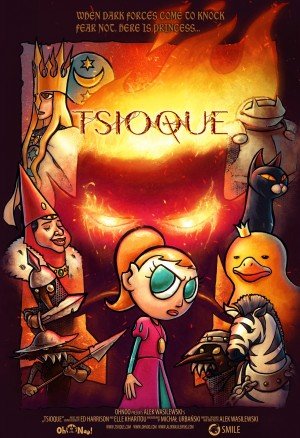Review for Pavilion: Chapter 1

Visiontrick Media’s Pavilion: Chapter 1 represents the first half of a “fourth-person puzzling adventure,” with players controlling not the game’s protagonist, but rather the environment around him. While not an entirely unique conceit, this iteration is buoyed from the start by an interesting mix of satisfying puzzles of varying difficulty, a gorgeous ambient soundtrack and lush visuals. However, the highly-symbolic and abstract narrative could benefit from more concreteness and an exploration of the player’s own god-like role. More problematic, the technical presentation suffers, especially late in the game, including levels freezing and bugs that cause skipping whole sections of the game, requiring workarounds to continue playing or to see what was missed. Thankfully these issues don’t sour the experience too much, but the glaring lack of polish noticeably tarnishes an otherwise enjoyable opening installment.
The goal in Pavilion is to help guide the protagonist through each of the game’s 28 isometric maze-like levels. This is, naturally, easier said than done most of the time, with obstacles of various kinds placed between the character’s starting point and the level’s exit. Such impediments range from the mundane, like locked doors and dark areas that must be illuminated, to the fantastic, such as giant moveable stone blocks that glow when your cursor hovers over them, and snarling wolf heads mounted on walls that come alive when your unnamed charge draws near.
While the primary objective is to figure out the correct sequence of actions to help the man navigate the area, there is added challenge in understanding how he will respond to the environment around him, and particularly to your manipulations. For instance, ringing large bronze bells or turning on certain lights might indicate a path he should take or a door he should move to, while activating a stone block’s glow might cause him to run over and huddle next to it, seeking shelter. Moving that same block might cause him to follow it as you guide it around, providing a way for him to traverse large swaths of darkness covering the level. Ultimately, your task is to learn how to nudge him the right way using the objects that you control.
It’s an interesting twist on the typical puzzle game mechanic in which player and protagonist are one and the same, and it works very well here. It can be frustrating at times if you can’t quite work out exactly what you are supposed to be doing, or how to change the protagonist’s behavior, but experimentation is part and parcel of Pavilion’s gameplay, and I found the solutions to most, if not exactly all, puzzles to be intuitive when I exercised patience and observed the cause-effect relationship between my actions and the responses of the character. As far as I could tell, there is no point at which the protagonist can outright die, so if you do something apparently foolish like running him into danger, either the game intends for you to do this (usually for narrative purposes) or else the man will return to the nearest designated safe area, signified by a fireplace-like object in front of which he amusingly warms his hands while waiting for your next instruction.
Given that the protagonist isn’t constantly roaming around, unlike similar fourth-person games like Back to Bed, you can usually complete levels at your own pace, though there are a few exceptions to this rule. Most notably are several sequences where you have a limited amount of time to execute your actions once you start them. These puzzles aren’t typically too complex, but some players who have dexterity issues may find a few of them difficult to solve. For most others I don’t expect this to be a problem, however. In general, the puzzling in Pavilion is very balanced and enjoyable. While not every level presents significant challenge, those that do are very satisfying to solve and tended to make me feel quite clever, especially if I took my time to work out an understanding of the mechanics, rather than trying solutions blindly and hoping for the best. Even one stage that is substantially more complex, involving a series of pressure plates that unlock doors, is solvable with patience and keen observation, though I became frustrated enough that I looked at a walkthrough (and felt a little dumb for missing the solution).
There are objects for the character to find, such as keys for locked doors, hidden inside dressers and out-of-the-way alcoves scattered throughout some levels, but these items are collected and used automatically, so there isn’t really an inventory system per se. A few objects like a photograph of an important in-game location seem to be completely optional to find, usually by taking secondary routes through a given stage, but while I was never certain as to whether they had a particular purpose gameplay-wise, they are not completely without relevance as they typically allude to narrative elements.
Speaking of narrative, this is one of two significant issues I have with Pavilion, though the second is more serious. I call it a “narrative” because to refer to the events that occur over the course of the game as a “story” would be fairly inaccurate. It’s not that things don’t happen to contextualize your actions, though I’m hesitant to get too specific since whatever mystery the game does build up can be easily spoiled by revealing too much. Suffice it to say that the apparent intent is to be an allegorical tale, rather than having a discrete plot as such. Unfortunately, Pavilion leaves too much to the player’s imagination, and feels unsatisfying as a result. Having reached the end (which, of course, only constitutes the first of two chapters), I believe I understand what the game is “about,” but it is very much open to speculation. Does the environment represent the protagonist’s mental state, perhaps? Who are you, the player? Given that you have a definite presence in the game distinct from that of the protagonist, what role are you playing? A god? The protagonist’s subconscious mind?
Questions like these present themselves over the course of the game, but while the approach works fine to get you intrigued, the experience would be better with a more tangible storytelling method – one that, perhaps, fleshes out the role of the player in this tale. Some will probably love this obtuse narrative style, and I myself can appreciate what the developers have attempted to do. But there is a fine line between symbolism used for a greater purpose, and sheer vagueness for its own sake, and in my view Pavilion too often leans toward the latter. Such an issue isn’t so much a critical flaw as an obvious opportunity lost, given that the other elements of the game succeed as well as they do.
The more serious problem is that a sizeable number of glitches afflict several levels, mostly later in the game. One particular scene froze in the same spot repeatedly, requiring a reset each time, a task achievable from the pause menu, until I was finally able to get past it. Another glitch skipped a scene only to arrive at a later level, requiring a manual return to the previous stage to see what I missed via the “memory map” feature in the main menu that allows you to replay the levels in their entirety once completed.
I also experienced a consistent issue where sound effects, particularly the protagonist’s footsteps, would get stuck in a loop and continue to play after the character had stopped moving, and bizarrely even kept going after quitting to the main menu. Luckily you can simply resume from the last completed scene within a level, so little if any progress is lost by exiting, unless in one of the few scenarios that are particularly sizable or contain a large number of steps needed to complete it. Other relatively minor glitches included backgrounds that failed to load, creating large swaths of black where the environment should have been, and one sequence with a telescope in which scenery seemed to change position each time I looked into the eyepiece, when it was presumably intended to be stationary. These latter problems could likewise be fixed by reloading the scene.
Graphically, Pavilion takes obvious cues from Art Nouveau and Neoclassicism, with both lush green tones and more earthy colors filling out surprisingly beautiful, varied dream-like environments. Striking yet vaguely unsettling disembodied marble heads reminiscent of Greek busts can be found scattered throughout numerous levels, some forming the walls themselves as though watching the protagonist as he struggles to follow your commands. Scenes that appear to take place in buildings or other domestic environments share the same color palette that imbues their sometimes-disheveled surroundings with a touch of opulence. Outdoor settings are similarly attractive, making good use of greens and browns to keep things visually interesting. It really is a gorgeous game, and some levels could easily be displayed in the real world as surrealist art. When juxtaposed against the strange machinery, giant glowing stone blocks, and other elements scattered about that constitute the raw materials of each level’s action, the overall effect is one of quiet mystery, tinged with a mildly threatening air.
The ambient soundtrack composed by Tony Gerber is also excellent, featuring a startling array of tones and textures. All of them are essentially downtempo instrumental pieces, with piano, guitar, and electronic synths making up a large part of the score, along with some other instruments I couldn’t identify. Each track is quite enjoyable and interesting on its own, but combined with the visuals manages to elevate the whole production to more than the sum of its parts. One piece in particular has Eastern influences that seem almost perfectly matched with the aethereal forest-like look of the particular set of levels it accompanies. Pavilion’s soundtrack is one of the best I’ve heard in a long time. Certainly it’s one of the most memorable, and the fact that it can stand as an album worth purchasing on its own says a lot about its quality. Sound effects such as footsteps, activating machines, the cracking of thunder and tolling of bells are likewise immersive and help to make the environment come alive as both you and the protagonist interact with it.
There are three control schemes to choose from: keyboard, mouse, and one that utilizes a peripheral called the Tobii Eye Tracker, which I did not test but purportedly can be used to guide Pavilion’s in-game cursor with your gaze. I found the keyboard scheme proved awkward, but the mouse option (which surprisingly was only patched-in after launch) felt far more natural, and works just like you’d expect. You are able to click on and drag around the various objects at your disposal, as well as move the cursor to the edges of the screen to scroll the viewport. It’s quick, easy, and fluid, although I found at some moments, like when the protagonist must be ferried around on a rail via a barge-like contraption, the controls tended to “stick” at junction points, making it hard to change direction. As these segments represent a fairly small part of the overall game, however, this was mostly a minor annoyance.
All in all, though Pavilion is held back from reaching its full potential by a few significant flaws, this debut episode is an impressive game that succeeds on multiple fronts. The largely environment-based puzzles are very fun and satisfying to solve, and the fourth-person gameplay mechanic is executed very well. While the inclusion of timed sequences might pose an additional challenge to less-dexterous players, most will find the vast majority of puzzles perfectly manageable, with logical solutions rewarding observation and patience. The ambient-style soundtrack is incredible, and the dreamy, surreal graphics are just as stunning. Only the overly-abstract narrative was a disappointment to me, along with the numerous glitches that presented themselves, especially towards the end. With its lack of polish and no sign of the concluding chapter on the horizon just yet, I hesitate to unreservedly recommend this opening installment, but given the very reasonable playtime of 4-5 hours (not including the various resets), there’s a lot of entertainment value here for puzzle fans who want to partake of something different wrapped in such gorgeous packaging.



























